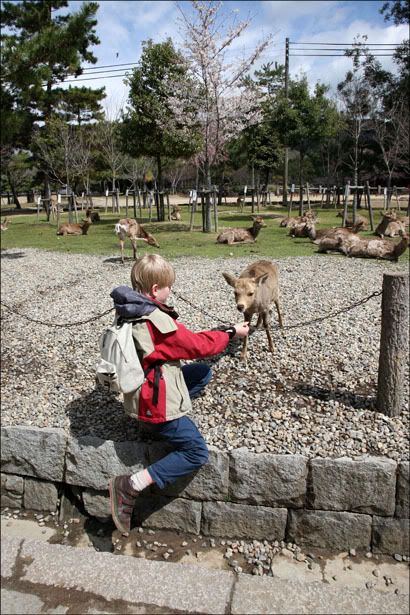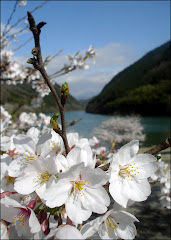
More tricksy deer work the crowded approach to Todaiji's great gate. Watch out girls, they bite!

A young boy shares his shika senbei with one of many sacred deer lounging along the tourist-infested main approach to the temple.

An artist sketches one of two nio, or "benevolent kings", enshrined in Todaiji's main gate, which is named after them (the nio-mon). Nio gaurd the entrance to most Buddhist temples in Japan in pairs, one with it's mouth open, the other, closed. Together, they represent Alpha and Omega, birth and death, the begining and the end. Created in 1203 AD, Nara's nio are the most famous in all of Japan, standing 26 feet tall.
 Tourists stop for a sakura-framed souvenier photograph along the corridor leading to the temple's thoroughfare.
Tourists stop for a sakura-framed souvenier photograph along the corridor leading to the temple's thoroughfare. Todaiji towers over visitors, dwarfing everything in sight. Certified as a UNESCO World Heritage site, Todaiji is one of Japan's most famous and historically significant temples. Despite the fact that the present reconstruction of the building, undertaken in 1692, is only two-thirds of the original size, Todaiji remains the largest wooden structure on earth, housing the world's largest cast iron Buddha at 57 meters wide, 50 meters deep, and 48 meters tall.
Todaiji towers over visitors, dwarfing everything in sight. Certified as a UNESCO World Heritage site, Todaiji is one of Japan's most famous and historically significant temples. Despite the fact that the present reconstruction of the building, undertaken in 1692, is only two-thirds of the original size, Todaiji remains the largest wooden structure on earth, housing the world's largest cast iron Buddha at 57 meters wide, 50 meters deep, and 48 meters tall. Sakura, silhouettes and stormy skies surround the home of Daibutsu-san, the Great Buddha of Nara. When the original construction had concluded in in 798, it was recorded that 50,000 carpenters, 370,000 metal workers, and 2.18 million laborers worked on its construction and furnishings, nearly bringing the nation to the brink of bankruptcy.
Sakura, silhouettes and stormy skies surround the home of Daibutsu-san, the Great Buddha of Nara. When the original construction had concluded in in 798, it was recorded that 50,000 carpenters, 370,000 metal workers, and 2.18 million laborers worked on its construction and furnishings, nearly bringing the nation to the brink of bankruptcy.
The Great Buddha of Nara is the world's largest cast iron Buddha, sitting at a staggering 14.98 meters and weighing 500 metric tonnes.
Framed by the temple's decorative woodwork and massive timber pillars.
The Great Buddha's left hand raised in the abhaya mudra, imparting fearlessness and reassurance.
Another temple gaudian, in full battle gear, glares ominously down at visitors.
A couple joins the crowd in snapping a few shots on their cell phones.
Like the buddha, this boddhisatva's left hand mudra offers reassurance. It's right hand depicts the Varada mudra, lowered with the palm facing outward, the gesture of bestowing blessings or of giving charity.




2 comments:
Super pictures, dude! You're awesome!
Man, how I envy your wide angle...
As always, great stuff.
P.S. Hurry up and come back!
I remember visiting the Nara temple, the deer were so cute and the perspective of the ceiling panels was dizzying. I wonder if there was a significance that the buddha's hands and the boddhisatva's hands are reversed (buddha has left raised while boddhisatva has the right raised). I can't remember...
Post a Comment